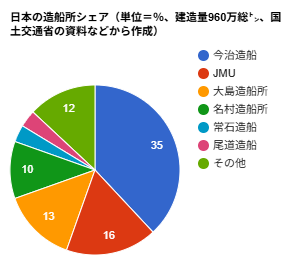Tsuneishi Renames Mitsui E&S Can Japan’s Shipbuilding Unite as One 三井E&Sの社名変更 日本造船は一枚岩になれるか

Tsuneishi Shipbuilding Renames Mitsui E&S Shipbuilding, Pursues Overseas Diversification Strategy While Imabari Consolidates Domestically—Can Japan’s Shipbuilding Industry Unite as One?
常石造船、「三井E&S造船」の社名変更。今治造船と異なる海外分散型、日本造船は一枚岩になれるか
Tsuneishi Shipbuilding will change the name of Mitsui E&S Shipbuilding to Tsuneishi Solutions Tokyo Bay Co., Ltd. as of June 30. With this renaming, Tsuneishi aims to consolidate its shipbuilding brand. In contrast to Imabari Shipbuilding, which operates a “domestically concentrated” model with numerous facilities along the Seto Inland Sea, Tsuneishi has built an “internationally diversified” structure with bases in China and the Philippines. These contrasting strategies between the two firms have become even more distinct in 2025.
In Japan, the term “maritime cluster” is commonly used. Just as the major shipping lines, domestic shipowners, trading house shipping divisions, and regional banks all have different characteristics, each shipyard in Japan’s shipbuilding industry also possesses its own historical background and corporate strategy. With Imabari now the largest shareholder of Japan Marine United (JMU), and Tsuneishi unifying its shipbuilding brand, the question remains: can Japan’s shipbuilding sector truly come together as one?
Key Takeaways from This Article
→ What distinguishes Imabari’s “domestically concentrated” strategy from Tsuneishi’s “internationally diversified” model?
→ How will non-conglomerate-affiliated shipbuilders such as Namura Shipbuilding, Oshima Shipbuilding, Shin Kurushima Dockyard, and Onomichi Dockyard position themselves within the “Japan-US Golden Age of Shipbuilding”?
This article also explores the historical context of Japan’s shipyards, highlighting the contrast with China and South Korea, where shipbuilding is advancing under state-driven industrial policy.

常石造船、「三井E&S造船」の社名変更。今治造船と異なる海外分散型、日本造船は一枚岩になれるか
常石造船は6月30日付で三井E&S造船の社名を「常石ソリューションズ東京ベイ株式会社」に変更する。常石造船は今回の三井E&S造船の社名変更で造船ブランドの統一を図る。今治造船が瀬戸内海沿岸に多数の拠点を有する「国内集中型」であるのに対し、常石造船は中国やフィリピンを拠点とした「海外分散型」の体制を築いている。両社の戦略は2025年に入りさらに明確化された。
日本では「海事クラスター」という言葉がよく使われる。海運大手や日本船主、商社船舶部、地方銀行の特色がそれぞれ異なるのと同様に、日本の造船業界でもそれぞれの造船所が持つ歴史的背景、事業戦略が大きく異なる。今治造船がJMUの筆頭株主となり、常石造船が造船ブランドを統一した今、果たして日本の造船業界は一枚岩になれるのか。
この記事のポイント
→今治造船の「国内集中型」、常石造船の「海外分散型」の事業戦略の相違とは何か。
→名村造船所、大島造船所、新来島どっく、尾道造船など非財閥系の造船所は今後、「日米造船黄金時代」にどのように合流するのか。
本文では日本の造船所の歴史的な背景のほか、国策として造船業を進める中国や韓国との違いを報じている。








コメント